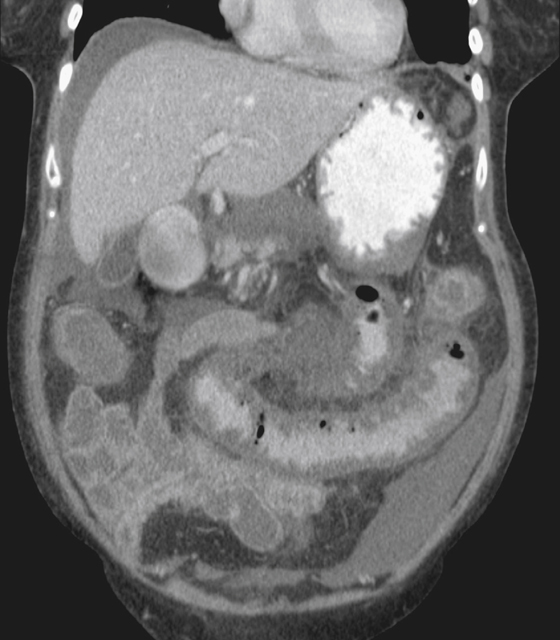CASE 179

History: A 54-year-old woman referred from the infectious diseases clinic presents with severe abdominal pain and diarrhea.
1. What should be included in the differential diagnosis of the imaging finding shown in the figure? (Choose all that apply.)
2. What is the most common organism involved in AIDS-related enteritis?
3. What is the most common cause of symptoms of impaired swallowing (dysphagia and odynophagia) in a patient with AIDS?
4. Which of the following diseases occurs in immunocompromised patients after bone marrow transplant but not in patients with AIDS?
ANSWERS
CASE 179
Patient with AIDS and Small Bowel Infection
1. B, C, and E
2. D
3. C
4. A
References
Jones B, Wall SD. Gastrointestinal disease in the immunocompromised host. Radiol Clin North Am. 1992;30(3):555-577.
Lappas JC. Small bowel imaging. Curr Opin Radiol. 1992;4(3):32-38.
Cross-Reference
Gastrointestinal Imaging: THE REQUISITES, 3rd ed, p 342.
Comment
In patients with AIDS, the small bowel is a common site for infection by opportunistic pathogens. The presenting symptoms are almost always abdominal pain and diarrhea. Although cryptosporidiosis appears to be the most common cause, other considerations include Mycobacterium avium complex (MAC), CMV infection, giardiasis, microsporidiosis, and histoplasmosis. The organism is usually identified by small bowel aspirates or biopsy. This case was an AIDS-related enteric infection (see figure). Barium studies and CT scans show abnormal small bowel, as in this case, which is nonspecific. In cases of enteric involvement of the small bowel with MAC, barium small bowel studies have described the changes in the small bowel as being similar to changes seen in Whipple’s disease. CMV infections are common in the colon and occur less frequently in the esophagus and small bowel of patients with AIDS. Bowel obstructions relating to CMV small bowel infection have been described.
When seen on CT images, the small bowel appears thickened and edematous in most patients. The possibility of small bowel lymphoma (non-Hodgkin’s lymphoma is common in patients with AIDS) must always be considered. Obstruction is uncommon. In older patients without AIDS, ischemic changes may have a similar appearance. Other neoplastic lesions described in the small bowel of patients with AIDS include Kaposi’s sarcoma.







